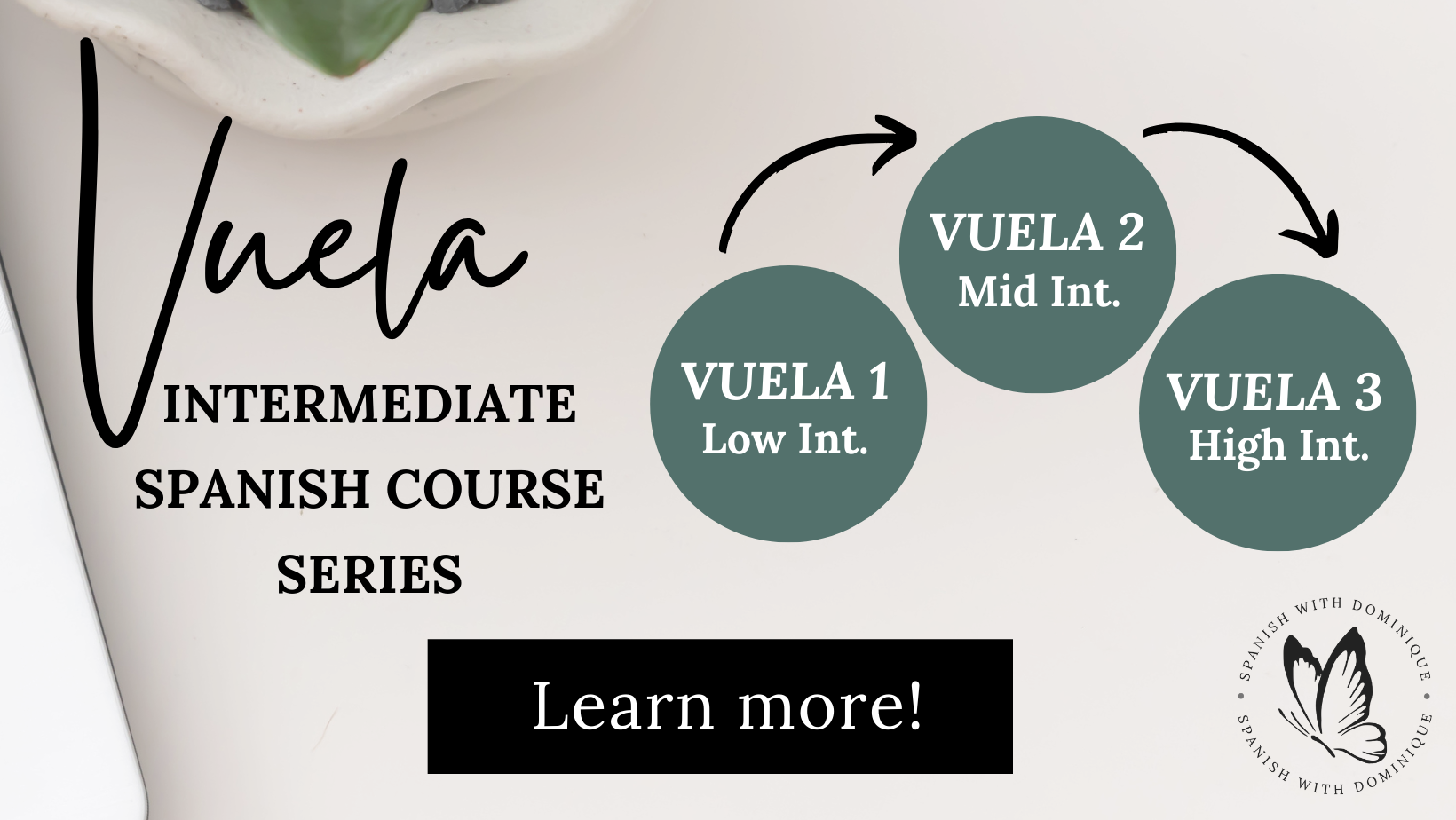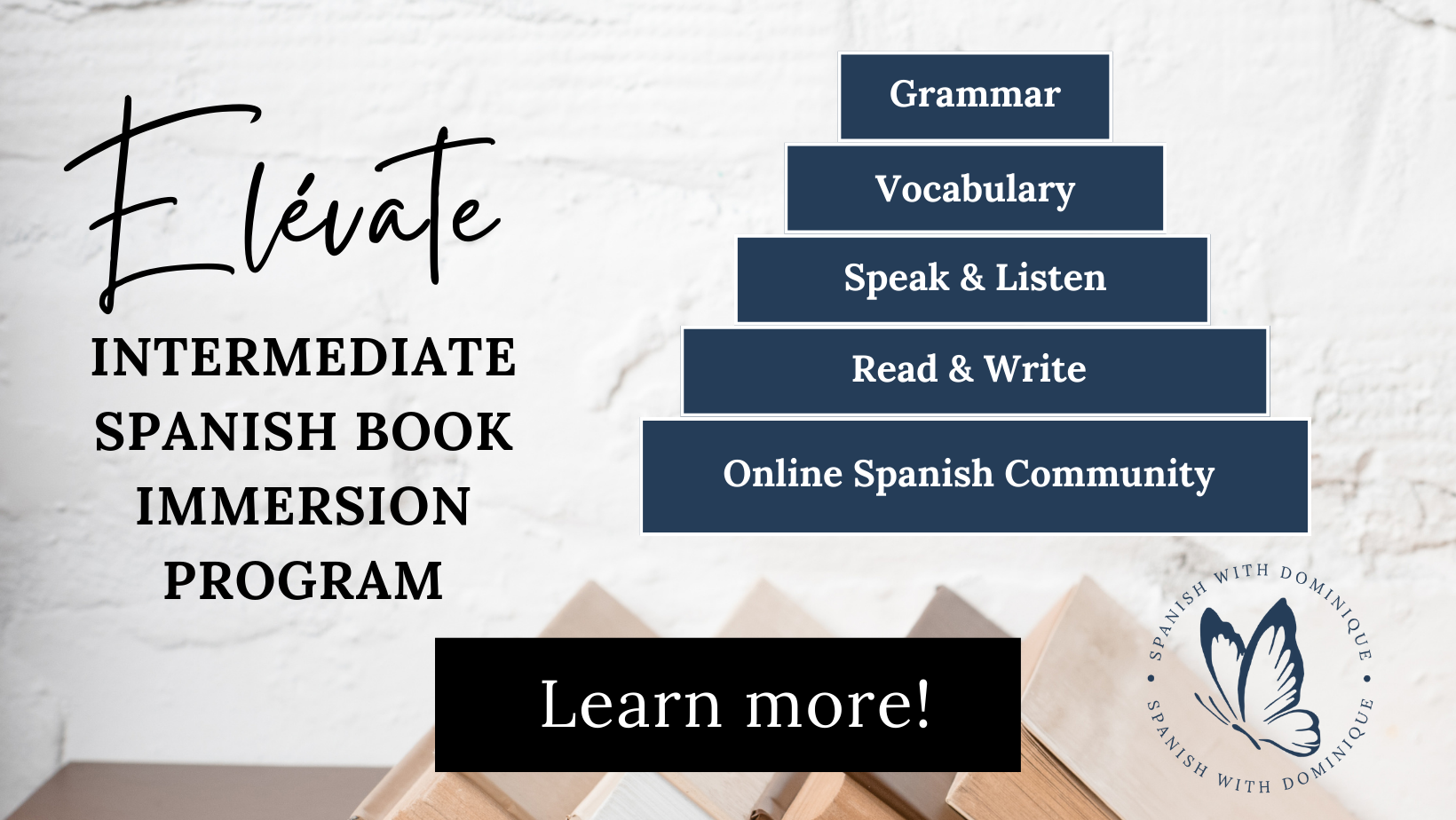The Best Way to Learn Spanish as an Adult: 3 Techniques You've Never Tried
In this post: Learn about the best ways to learn Spanish as an adult with three research-based techniques for learning Spanish for adults.
“How will I find time to learn Spanish between everything in my already packed schedule?”
As an adult who wants to learn Spanish, this is a valid question I hear a lot.
I mean, there are the kids, then work, then the dog, maintaining your friendships and your figure. Oh, and can’t forget to spend time with your husband!
How in the world are you going to squeeze Spanish in there, too?
So, you’re at a standstill: you can’t add more hours to your day, and you also don’t want to put off learning the language until you’re less busy (because we all know that’s never going to happen!).
Finding time is a common roadblock for most people that creates a lot of starting and stopping when it comes to learning Spanish, making us feel dejected about the whole process.
Well, you might be surprised to discover something:
With the right techniques in place, there is time. You just have to prioritize Spanish a bit and follow my daily practice hacks to make it happen.
In this guide, I’ll unveil three innovative approaches to learning Spanish that you’ve probably never tried.
By design, these methods help you fit Spanish into your life--especially when things get messy or hectic.
Knowing you have options to fit practicing the language into your day can be the difference between making progress with a Spanish learning habit that works for you. Or staying stuck because you feel like there’s no time.
Read on and see which of these techniques you could adopt today to transform learning Spanish from a daunting quest to a series of simple tasks you can pick up and do in the time you have.
Ready to get started?
While reading this post, consider these questions:
What kind of Spanish conversations do you hope to be having in 6 months?
What are the biggest challenges to keeping your Spanish practice consistent right now?
Do you feel focused and effective when you practice Spanish? Or distracted and a little ‘off’?
#1. Tap into time management and short bursts of study for quick wins.
When you’re an adult learning Spanish, there’s one thing you can’t afford to forget: The best way for you to learn Spanish is one that fits into your life.
As an adult, you need to learn to cater your Spanish practice to your own learning style and interests. You’ll also need to tailor your approach to your schedule, family commitments, and level of focus.
Depending on your situation, use one of the following techniques to boost your Spanish practice now--by making the most of the time you have.
If you’re short on time, add microlearning to your Spanish practice.
This is a great tool to use if you feel like you just can’t find the time to learn Spanish.
You can also use this if this happens to you:
You finally have a minute to focus between running the kids to soccer or caring for older family members--and you struggle to focus!
If that sounds like you, you’re not alone. There is quite a bit of research on the fast pace of today’s life and the amount of information we have to juggle.
It can leave you feeling like time and attention span are luxuries you can’t afford. This is exactly why some language education researchers are turning to microlearning.
So, how can you use microlearning to help you learn Spanish as an adult?
Break down what you want to learn into small, manageable chunks. To set yourself up for success, select learning tasks and activities you can complete in 10-15 minutes.
You’d be surprised at the variety of ways you can study Spanish for 10 minutes at a time.
Consider activities like listening to a short Spanish podcast in one session, reading the transcript in another 10-minute burst, and looking up new words in a later short session.
You could also break down your Spanish writing practice into micro-sessions by writing a short journal entry in Spanish or messaging on WhatsApp, for example.
Microlearning is ideal for busy adults who only have a few minutes at a time--or a few minutes of attention. It can be done anywhere, anytime, without the need for a strict schedule.
And it’s extremely effective. By focusing on keeping your Spanish practice short and simple, you’ll make it easier for yourself to absorb and retain information.
What if you have more time but need help staying focused?
Making time for Spanish practice is a real problem for many adults, but even those who can spare an hour or two run into challenges!
Why? Because it’s not always easy to focus for that long.
For many people, committing to a two-hour (or even one-hour) Spanish session can sound daunting.
You may even resist or refrain from practicing Spanish when you do have the time just because it feels like too much. Frustrating, I know.
If that sounds familiar, then the Pomodoro technique could be a game-changer for you. It helps you stay focused over extended periods by scheduling breaks into your Spanish session.
Here’s how to use the Pomodoro Technique to boost your Spanish Practice.
To get started with this technique, you’ll want to have a timer and your Spanish learning materials ready to go.
Set your timer for 25 minutes and see how much easier it is to focus when you know it’s just for a little while.
Then, take a 5-minute break. Really. Step away from your desk. Get up and move. Have a cup of tea.
Repeat this process for as long as you have time to devote to your Spanish--whether you have 30 minutes, an hour, or more.
As you experiment with this approach, consider thinking beforehand about what you’d like to do in 25 minutes. Here are some suggestions for your 25-minute sessions:
Read a few pages of your Spanish workbook and underline phrases you don’t understand.
Review your vocabulary journal and write sentences with the words you want to remember.
Listen to a podcast once to see what you understand, then read the transcript and underline any phrases you missed the first time.
The Pomodoro technique is excellent for tackling more extended periods of Spanish learning while maintaining focus and preventing burnout.
Then there’s my go-to time management tool for adults learning Spanish: The Sprint.
For many of us, the reality looks like this: we can find an hour a day to focus on Spanish--for a few weeks or even a couple of months.
But what about those times of the year when we need to devote more time to family, travel, or just the holidays?
The trick is to adjust your Spanish practice to the natural ebb and flow of life.
You see, the notion of having “balance” in your life is an illusion.
In reality, as adults, our time and focus is a pendulum swinging between varying priorities.
During the summer, for example, the pendulum might swing more towards family, as kids are out of school and require more attention.
While in the winter, you may have a lot of extra downtime as you hunker down during the colder months allowing more time to focus on hobbies.
You can both respect and capitalize on that pendulum swing of shifting priorities when it comes to learning Spanish (something I teach in my Monarch Method for Learning Spanish).
It revolves around taking sprints and breaks throughout the year.
For 4-6 weeks, work intensively on your Spanish--perhaps setting aside an hour or more a day to study.
You can do this in a guided format with an intensive program or by finding a teacher who really aligns with your goals and pushes you.
Then, you dig into your learning and commit to focusing.
But just for a couple of months.
Then take a break.
This is the best way to make your Spanish practice fit your lifestyle.
On that note, here’s one more idea for ensuring you show up to practice Spanish every day.
#2 Make Spanish an authentic part of your daily life.
This is one of the most important steps you can take to make your Spanish practice feel authentic and relevant.
In short, it helps you remember why you’re so committed to learning Spanish in the first place so that the motivation to show up and practice comes naturally.
You don't need hours of free time or a complete lifestyle overhaul to begin. Just take one small and significant step at a time.
Here are some ways to make Spanish a part of your day:
Make your commute more fun by adding Spanish.
Turn your daily commute into a lively Spanish learning session. Immerse yourself in the language with Spanish podcasts, audiobooks, or music. If you’re driving kids to activities, playing Spanish music or kid-friendly audiobooks can make learning fun and engaging for both adults and children.
Narrate Your Day in Spanish
Challenge yourself to think and speak in Spanish while performing daily tasks. Whether you're gardening, shopping, or doing household chores, give voice to what you’re doing in Spanish.
This method helps you build vocabulary, think on your feet, and get comfortable with the language in a practical setting.
Exercise with Spanish
Combine physical activity with language learning. This approach is great for anyone who needs to move while learning. You could take a walk while chatting with your language exchange partner or simply tune into your favorite Spanish podcast.
Create a Spanish-Infused Environment
Label objects in your home in Spanish. This constant visual reminder helps you memorize everyday vocabulary effortlessly. Switching to Spanish news channels or reading Spanish newspapers can immerse you in the language and culture.
For another easy win, change the language of your phone and internet browser to Spanish, too.
Explore Latino Culture and Communities
Visiting Latino neighborhoods is a fantastic way to hear different Spanish dialects. Places like East LA, Pilsen in Chicago, or Little Havana in Miami offer rich cultural experiences and language practice opportunities.
Shop at Latino Grocery Stores
Shopping at Latino grocery stores or going to the local farmer’s market and engaging with Spanish-speaking vendors exposes you to cultural products and allows you to interact in Spanish.
Most of us can’t avoid shopping for food, so this is a great way to ensure you’ll get some authentic Spanish simultaneously.
Engage in Local Community Events
Community events, such as local Latino festivals or attending Spanish mass at churches, are another great way to expand your horizons, get engaged with your community, and immerse yourself in Spanish.
Utilize Educational Resources and Social Interaction
Joining Spanish meetups or cultural hobby groups, like a Latin dance studio or a soccer club, blends language learning with social interaction. Libraries, with their Spanish sections, are excellent places for children and adults to hear and speak Spanish.
Remember, the key to learning Spanish is staying consistent by making your Spanish practice doable, enjoyable, and a natural part of your life. Try any of these, take the time pressure off your Spanish learning, and enjoy the language, regardless of your schedule or lifestyle.
One of the best ways to learn Spanish as an adult is to keep your Spanish practice fun and rewarding. Speaking of which…
#3 Don’t underestimate the importance of rewarding yourself.
Some of us think of sticker charts and kids when it comes to rewarding ourselves for keeping up our great habits.
But the research is clear: tracking our progress and rewarding ourselves is also a boost for adults learning Spanish.
In fact, tracking your progress and rewarding yourself has been so helpful to many adults I work with that I include a mini-workshop on the topic in both my ALAS Basic Spanish Course Series and VUELA Intermediate Spanish Course Series.
You can start by deciding what habits you want to foster and celebrating your small wins.
Start by setting realistic, attainable new habits to put in place.
How much time do you want to spend on your Spanish each day? 15 minutes? 30?
Do you want to read a certain number of pages from your book? Or watch a part of your series on Netflix?
Double-check your goal to make sure you can do it consistently. If in doubt, set a more manageable one.
Once you achieve a goal, no matter how small, don’t forget to celebrate it.
Create a reward system that boosts your Spanish learning and keeps you going.
Design a reward system that makes learning Spanish fun.
For instance, for every hour spent practicing, you could add a small amount to a “Spanish fund.”
Once your “fund” reaches a certain amount, use it to buy something that contributes to your Spanish practice in a fun way.
Is there a Spanish novel you’ve been meaning to read? A Spanish-language film or play you’d love to attend? Or even a Spanish-speaking country you’d love to visit?
Do you prefer social rewards? Go for it.
Rewards don't always have to be material. They can be social and experiential, too.
You could reward yourself for sticking to your Spanish habits for a week by planning a Spanish-themed evening with friends where you cook Mexican dishes and play your favorite Spanish music in the background.
Don’t forget that personal growth is a reward, too.
With language learning, we don’t always see the rewards we create for ourselves and our families as we show up to practice each day.
But over time, you can find reward by realizing the impact you have in your community. Imagine yourself helping visitors and tourists who speak Spanish in your community or assisting refugees in filling out important paperwork at the center where you volunteer.
One of the most beautiful rewards I’ve seen people reap as they become genuinely conversational in Spanish is the new relationships they build because of the language.
To help you visualize your personal Spanish growth, keep a journal of your progress and occasionally look back to see how far you’ve come.
Takeaways:
The techniques I’ve shared in this post will help you incorporate Spanish into your routine in doable and repeatable ways that fit your lifestyle.
Making sure your Spanish practice fits your schedule and becomes a natural and authentic part of your day will help you avoid the frustration that comes from feeling like you don’t have the time or the attention span to make real progress.
You can help keep your Spanish habits consistent over time by weaving in a tracking and reward system.
But, maybe becoming “proficient” in Spanish is not the most important thing you’ll get from these techniques.
As one of my favorite authors and experts on habit-building puts it,
"Habits matter because they help you become the person you wish to be."
--James Clear
Maybe you’ll become someone who can travel to Mexico knowing that you have the language skills to ‘get by,’ meet locals, and enjoy some incredible conversations.
Maybe you’ll become a parent and partner in a fully bilingual family. Or a grandchild who can connect with abuela in Spanish.
And that’s the question I’d like to leave you with today:
Who will you become when you add Spanish to your daily life?







Discover 7 must-read books for intermediate Spanish learners to boost fluency, overcome the plateau, and immerse yourself in engaging Spanish stories.